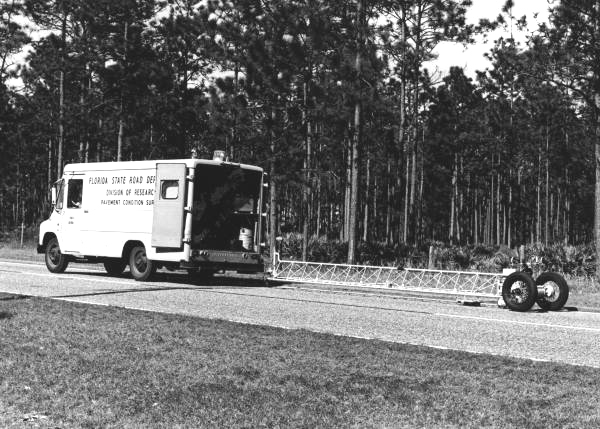|
Crocodile Cracking
Crocodile cracking, also called alligator cracking and perhaps misleadingly fatigue cracking, is a common type of distress in asphalt pavement. The following is more closely related to fatigue cracking which is characterized by interconnecting or interlaced cracking in the asphalt layer resembling the hide of a crocodile. Cell sizes can vary in size up to across, but are typically less than across. Fatigue cracking is generally a loading failure, but numerous factors can contribute to it. It is often a sign of sub-base failure, poor drainage, or repeated over-loadings. It is important to prevent fatigue cracking, and repair as soon as possible, as advanced cases can be very costly to repair and can lead to formation of potholes or premature pavement failure. It is usually studied under the transportation section of civil engineering. Causes Fatigue cracking is an asphalt pavement distress most often instigated by failure of the surface due to traffic loading. However, fatig ... [...More Info...] [...Related Items...] OR: [Wikipedia] [Google] [Baidu] |
Asphalt Deterioration
Asphalt, also known as bitumen (, ), is a sticky, black, highly viscosity, viscous liquid or semi-solid form of petroleum. It may be found in natural deposits or may be a refined product, and is classed as a Pitch (resin), pitch. Before the 20th century, the term asphaltum was also used. Full text at Internet Archive (archive.org) The word is derived from the Ancient Greek ἄσφαλτος ''ásphaltos''. The largest natural deposit of asphalt in the world, estimated to contain 10 million tons, is the Pitch Lake located in La Brea, Trinidad and Tobago, La Brea in southwest Trinidad (Antilles island located on the northeastern coast of Venezuela), within the Siparia Regional Corporation. The primary use (70%) of asphalt is in Road surface, road construction, where it is used as the glue or binder mixed with construction aggregate, aggregate particles to create asphalt concrete. Its other main uses are for bituminous waterproofing products, including production of roofing fel ... [...More Info...] [...Related Items...] OR: [Wikipedia] [Google] [Baidu] |
Patterns
A pattern is a regularity in the world, in human-made design, or in abstract ideas. As such, the elements of a pattern repeat in a predictable manner. A geometric pattern is a kind of pattern formed of geometric shapes and typically repeated like a wallpaper design. Any of the senses may directly observe patterns. Conversely, abstract patterns in science, mathematics, or language may be observable only by analysis. Direct observation in practice means seeing visual patterns, which are widespread in nature and in art. Visual patterns in nature are often chaotic, rarely exactly repeating, and often involve fractals. Natural patterns include spirals, meanders, waves, foams, tilings, cracks, and those created by symmetries of rotation and reflection. Patterns have an underlying mathematical structure; indeed, mathematics can be seen as the search for regularities, and the output of any function is a mathematical pattern. Similarly in the sciences, theories explain and predict reg ... [...More Info...] [...Related Items...] OR: [Wikipedia] [Google] [Baidu] |
Mechanical Failure Modes
Mechanical may refer to: Machine * Machine (mechanical), a system of mechanisms that shape the actuator input to achieve a specific application of output forces and movement * Mechanical calculator, a device used to perform the basic operations of arithmetic * Mechanical energy, the sum of potential energy and kinetic energy * Mechanical system, a system that manages the power of forces and movements to accomplish a task * Mechanism (engineering), a portion of a mechanical device Other * Mechanical (character), one of several characters in Shakespeare's ''A Midsummer Night's Dream'' * A kind of typeface in the VOX-ATypI classification See also * Machine, especially in opposition to an electronic item * ''Mechanical Animals'', the third full-length studio release by Marilyn Manson * Manufactured or artificial, especially in opposition to a biological or natural component * Automation, using machine decisions and processing instead of human * Mechanization, using machine labor in ... [...More Info...] [...Related Items...] OR: [Wikipedia] [Google] [Baidu] |
Road Infrastructure
A road is a linear way for the conveyance of traffic that mostly has an improved surface for use by vehicles (motorized and non-motorized) and pedestrians. Unlike streets, the main function of roads is transportation. There are many types of roads, including parkways, avenues, controlled-access highways (freeways, motorways, and expressways), tollways, interstates, highways, thoroughfares, and local roads. The primary features of roads include lanes, sidewalks (pavement), roadways (carriageways), medians, shoulders, verges, bike paths (cycle paths), and shared-use paths. Definitions Historically many roads were simply recognizable routes without any formal construction or some maintenance. The Organization for Economic Co-operation and Development (OECD) defines a road as "a line of communication (travelled way) using a stabilized base other than rails or air strips open to public traffic, primarily for the use of road motor vehicles running on their own wheels", w ... [...More Info...] [...Related Items...] OR: [Wikipedia] [Google] [Baidu] |
Pavement Engineering
Pavement engineering is a branch of civil engineering that uses engineering techniques to design and maintain flexible (asphalt) and rigid (concrete) pavements. This includes streets and highways and involves knowledge of soils, hydraulics, and material properties. Pavement engineering involves new construction as well as rehabilitation and maintenance of existing pavements. Maintenance often involves using engineering judgment to make maintenance repairs with the highest long-term benefit and lowest cost. The Pavement Condition Index (PCI) is an example of an engineering approach applied to existing pavements. Another example is the use of a falling weight deflectometer (FWD) to non-destructively test existing pavements. Calculation of pavement layer strengths can be performed from the resulting deflection data. The two methods - empirical or mechanistic is used to determine pavement layer thicknesses. The evaluation of existing road pavements is done based on 3 factors: * Func ... [...More Info...] [...Related Items...] OR: [Wikipedia] [Google] [Baidu] |
Rut (roads)
A rut is a depression or groove worn into a road or path by the travel of wheels or skis. Ruts can be formed by wear, as from studded snow tires common in cold climate areas, or they can form through the deformation of the asphalt concrete, pavement or subbase material. In modern roads the main cause is heavily loaded trucks. These heavy loaded trucks imprint their tire impressions on roads over time, causing ruts. Rut is a common pavement distress and is often used in pavement performance modeling. Ruts prevent rainwater from flowing to the side of the road into ditches or gutters. Rainwater trapped in ruts is a common contributing factor to hydroplaning crashes. Severe ruts can impede steering if a vehicle has difficulty steering out of the rut. If it proves impossible to steer out of a rut, though forward and backward progress can be made by the vehicle, it is referred to as being stuck in the rut. Ruts in gravel roads can be removed by grading the road surface. Ruts in asph ... [...More Info...] [...Related Items...] OR: [Wikipedia] [Google] [Baidu] |
Road Texture
Road surface textures are deviations from a planar and smooth surface, affecting the vehicle/tyre interaction. Pavement texture is divided into: microtexture with wavelengths from 0 mm to , macrotexture with wavelengths from to and megatexture with wavelengths from to . Microtexture Microtexture (MiTx) is the collaborative term for a material's crystallographic parameters and other aspects of micro-structure: such as morphology, including size and shape distributions; chemical composition; and crystal orientation and relationships While vehicle suspension deflection and dynamic tire loads are affected by longer wavelength ( roughness), road texture affects the interaction between the road surface and the tire footprint. Microtexture has wavelengths shorter than 0.5 mm. It relates to the surface of the binder, of the aggregate, and of contaminants such as rubber deposits from tires. The mix of the road material contributes to dry road surface friction. Typically, road ... [...More Info...] [...Related Items...] OR: [Wikipedia] [Google] [Baidu] |
Pattern
A pattern is a regularity in the world, in human-made design, or in abstract ideas. As such, the elements of a pattern repeat in a predictable manner. A geometric pattern is a kind of pattern formed of geometric shapes and typically repeated like a wallpaper design. Any of the senses may directly observe patterns. Conversely, abstract patterns in science, mathematics, or language may be observable only by analysis. Direct observation in practice means seeing visual patterns, which are widespread in nature and in art. Visual patterns in nature are often chaotic, rarely exactly repeating, and often involve fractals. Natural patterns include spirals, meanders, waves, foams, tilings, cracks, and those created by symmetries of rotation and reflection. Patterns have an underlying mathematical structure; indeed, mathematics can be seen as the search for regularities, and the output of any function is a mathematical pattern. Similarly in the sciences, theories explain and predict reg ... [...More Info...] [...Related Items...] OR: [Wikipedia] [Google] [Baidu] |
Bleeding (roads)
Bleeding or flushing is shiny, black surface film of asphalt on the road surface caused by upward movement of asphalt in the pavement surface. Common causes of bleeding are too much asphalt in asphalt concrete, hot weather, low space air void content and quality of asphalt. Bleeding is a safety concern since it results in a very smooth surface, without the texture required to prevent hydroplaning. Road performance measures such as IRI cannot capture the existence of bleeding as it does not increase the surface roughness. But other performance measures such as PCI do include bleeding. See also * Pavement Condition Index * International Roughness Index *Asphalt concrete * Road slipperiness Road slipperiness is a condition of low skid resistance due to insufficient road friction. It is a result of snow, ice, water, loose material and the texture of the road surface on the traction produced by the wheels of a vehicle. Road slipperin ... References Asphalt Road construction ... [...More Info...] [...Related Items...] OR: [Wikipedia] [Google] [Baidu] |
Alkali–silica Reaction
The alkali–silica reaction (ASR), more commonly known as concrete cancer, is a deleterious swelling reaction that occurs over time in concrete between the highly alkaline cement paste and the reactive amorphous (''i.e.'', non-crystalline) silica found in many common aggregates, given sufficient moisture. This deleterious chemical reaction causes the expansion of the altered aggregate by the formation of a soluble and viscous gel of sodium silicate (Na2SiO3, also noted Na2H2SiO4, or N-S-H (sodium silicate hydrate), depending on the adopted convention). This hygroscopic gel swells and increases in volume when absorbing water: it exerts an expansive pressure inside the siliceous aggregate, causing spalling and loss of strength of the concrete, finally leading to its failure. ASR can lead to serious cracking in concrete, resulting in critical structural problems that can even force the demolition of a particular structure. The expansion of concrete through reaction between cemen ... [...More Info...] [...Related Items...] OR: [Wikipedia] [Google] [Baidu] |
Core Sample
A core sample is a cylindrical section of (usually) a naturally-occurring substance. Most core samples are obtained by drilling with special drills into the substance, such as sediment or rock, with a hollow steel tube, called a core drill. The hole made for the core sample is called the "core hole". A variety of core samplers exist to sample different media under different conditions. More continue to be invented on a regular basis. In the coring process, the sample is pushed more or less intact into the tube. Removed from the tube in the laboratory, it is inspected and analyzed by different techniques and equipment depending on the type of data desired. Core samples can be taken to test the properties of manmade materials, such as concrete, ceramics, some metals and alloys, especially the softer ones. Core samples can also be taken of living things, including human beings, especially of a person's bones for microscopic examination to help diagnose diseases. Methods The compo ... [...More Info...] [...Related Items...] OR: [Wikipedia] [Google] [Baidu] |






